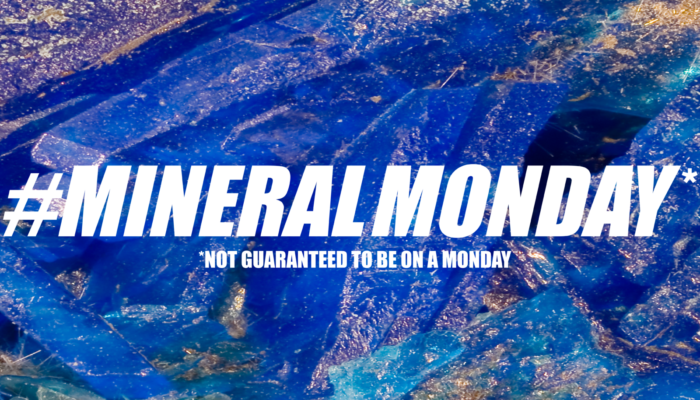
#mineralmonday: your weekly* dose of obscure mineralogy, every Monday** [*not guaranteed; **or possibly Tuesday-Sunday]
What is it? Lazurite. Take a deep breath, the formula is Na3CaAl3Si3O12S.
That’s a lot of elements to digest, what does it mean? Well, the aluminium (Al) and silicon (Si) form tetrahedra (4-faced 3D triangular shapes), with oxygen (O) on the points. These are arranged in rings with the sodium (Na) and calcium (Ca), with the sulphur (S) sitting in the middle. This kind of structure is called a cyclosilicate, because of the cyclical (ring shaped) arrangment.
OK now I’m bored. Is it pretty? Not just pretty – but pretty on a biblical scale. Lazurite is what makes lapis lazuli blue – this has been a semi precious stone for thousands of years. It’s basically lazurite with a couple of other minerals (we’ll get there another day). Here is a shout out from the Old Testament (Exodus): “Under his feet there seemed to be a surface of brilliant blue lapis lazuli, as clear as the sky itself“.
Alright I’m sold, where can I get some for under my own feet? The main worldwide source of lapis lazuli, and hence lazurite, is a mining district in northern Afghanistan. It’s been mined through the times of the Greek, Roman, Mesopotamian and Egyptian empires. As well as being used for carvings, jewelery and apparently flooring, ground up lapis lazuli / lazurite was used for making the colour ultramarine, widely used by painters in the Renaissance.
If more minerals were blue then geology would be way more interesting, right? Probably. There are only so many ways we can describe the colours grey and brown when looking at rocks. The colour comes from the sulphur, but exactly how the sulphur relates to the colour is still apparently up for some debate.
And who or what is lazurite named after? Simply, named for the colour blue. In Persian, this is lāzhward, which was originally the name of the place where the blue lapis lazuli stone was mined, which then ended up being used to describe the colour itself.
So the mineral was named after the colour, which was named after the town, which was named after the stone. I’m confused. Me too. It’s like time travel movies. Don’t think about it too much.
Do you have a favourite obscure mineral? Want to write about it? Contact us and give it a go!



Jo Condon
Really apprecite the humour and punchiness of the leading graphic, and also story. Well done 🙂